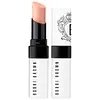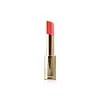What's inside
What's inside
 Key Ingredients
Key Ingredients

 Benefits
Benefits

 Concerns
Concerns

 Ingredients Side-by-side
Ingredients Side-by-side

Hydrogenated Polyisobutene
EmollientPhytosteryl/Isostearyl/Cetyl/Stearyl/Behenyl Dimer Dilinoleate
Skin ConditioningPolyglyceryl-10 Decaisostearate
EmollientPhytosteryl/Octyldodecyl Lauroyl Glutamate
Skin ConditioningMicrocrystalline Wax
Emulsion StabilisingOctyldodecanol
EmollientPolyethylene
AbrasiveCetearyl Alcohol
EmollientOctyldodecyl Neopentanoate
EmollientCaprylic/Capric Triglyceride
MaskingHydrogenated Olive Oil
Skin ConditioningEthylene/Propylene Copolymer
AbrasiveEthylhexyl Palmitate
EmollientSqualane
EmollientPersea Gratissima Oil
Skin ConditioningSimmondsia Chinensis Seed Oil
EmollientOrbignya Oleifera Seed Oil
EmollientTheobroma Cacao Seed Butter
EmollientButyrospermum Parkii Butter
Skin ConditioningOlea Europaea Oil Unsaponifiables
Skin ConditioningOlea Europaea Fruit Oil
MaskingPalmitoyl Tripeptide-1
Skin ConditioningLactic Acid
BufferingCholesterol
EmollientCeramide Ng
Skin ConditioningTribehenin
EmollientSorbitan Isostearate
EmulsifyingSorbitan Oleate
EmulsifyingParfum
MaskingCitral
PerfumingLinalool
PerfumingLimonene
PerfumingTocopherol
AntioxidantBHT
AntioxidantAscorbyl Palmitate
AntioxidantTocopheryl Acetate
AntioxidantPentaerythrityl Tetra-Di-T-Butyl Hydroxyhydrocinnamate
AntioxidantMica
Cosmetic ColorantCI 77891
Cosmetic ColorantCI 77491
Cosmetic ColorantCI 77492
Cosmetic ColorantCI 77499
Cosmetic ColorantCI 77163
Cosmetic ColorantCI 42090
Cosmetic ColorantCI 77400
Cosmetic ColorantCI 77742
Cosmetic ColorantCI 45370
Cosmetic ColorantCI 15850
Cosmetic ColorantCI 45380
Cosmetic ColorantCI 45410
Cosmetic ColorantCI 73360
Cosmetic ColorantCI 17200
Cosmetic ColorantCI 19140
Cosmetic ColorantCI 15985
Cosmetic ColorantHydrogenated Polyisobutene, Phytosteryl/Isostearyl/Cetyl/Stearyl/Behenyl Dimer Dilinoleate, Polyglyceryl-10 Decaisostearate, Phytosteryl/Octyldodecyl Lauroyl Glutamate, Microcrystalline Wax, Octyldodecanol, Polyethylene, Cetearyl Alcohol, Octyldodecyl Neopentanoate, Caprylic/Capric Triglyceride, Hydrogenated Olive Oil, Ethylene/Propylene Copolymer, Ethylhexyl Palmitate, Squalane, Persea Gratissima Oil, Simmondsia Chinensis Seed Oil, Orbignya Oleifera Seed Oil, Theobroma Cacao Seed Butter, Butyrospermum Parkii Butter, Olea Europaea Oil Unsaponifiables, Olea Europaea Fruit Oil, Palmitoyl Tripeptide-1, Lactic Acid, Cholesterol, Ceramide Ng, Tribehenin, Sorbitan Isostearate, Sorbitan Oleate, Parfum, Citral, Linalool, Limonene, Tocopherol, BHT, Ascorbyl Palmitate, Tocopheryl Acetate, Pentaerythrityl Tetra-Di-T-Butyl Hydroxyhydrocinnamate, Mica, CI 77891, CI 77491, CI 77492, CI 77499, CI 77163, CI 42090, CI 77400, CI 77742, CI 45370, CI 15850, CI 45380, CI 45410, CI 73360, CI 17200, CI 19140, CI 15985
Polyglyceryl-2 Triisostearate
EmulsifyingPhytosteryl/Isostearyl/Cetyl/Stearyl/Behenyl Dimer Dilinoleate
Skin ConditioningHydrogenated Polyisobutene
EmollientDipentaerythrityl Hexa C5-9 Acid Esters
Skin ConditioningDiphenylsiloxy Phenyl Trimethicone
Skin ConditioningSynthetic Wax
AbrasiveCeresin
Emulsion StabilisingEthylhexyl Methoxycinnamate
UV AbsorberMicrocrystalline Wax
Emulsion StabilisingEthylene/Propylene Copolymer
AbrasiveDiisostearyl Malate
EmollientCaprylic/Capric Triglyceride
MaskingLedebouriella Divaricata Root Extract
Skin ConditioningGlycyrrhiza Glabra Root Extract
BleachingCimicifuga Racemosa Root Extract
AntimicrobialPanax Ginseng Root Extract
EmollientPaeonia Lactiflora Extract
AstringentPueraria Lobata Root Extract
HumectantAngelica Acutiloba Root Extract
Skin ConditioningCornus Officinalis Fruit Extract
Skin ConditioningVelvet Extract
HumectantThymus Vulgaris Extract
PerfumingTalc
AbrasiveAmber Powder
CI 77480
Cosmetic ColorantPearl Powder
Carthamus Tinctorius Flower Extract
Skin ConditioningCellulose
AbsorbentCI 77891
Cosmetic ColorantCI 45410
Cosmetic ColorantCI 15850
Cosmetic ColorantCI 19140
Cosmetic ColorantParfum
MaskingPolyglyceryl-2 Triisostearate, Phytosteryl/Isostearyl/Cetyl/Stearyl/Behenyl Dimer Dilinoleate, Hydrogenated Polyisobutene, Dipentaerythrityl Hexa C5-9 Acid Esters, Diphenylsiloxy Phenyl Trimethicone, Synthetic Wax, Ceresin, Ethylhexyl Methoxycinnamate, Microcrystalline Wax, Ethylene/Propylene Copolymer, Diisostearyl Malate, Caprylic/Capric Triglyceride, Ledebouriella Divaricata Root Extract, Glycyrrhiza Glabra Root Extract, Cimicifuga Racemosa Root Extract, Panax Ginseng Root Extract, Paeonia Lactiflora Extract, Pueraria Lobata Root Extract, Angelica Acutiloba Root Extract, Cornus Officinalis Fruit Extract, Velvet Extract, Thymus Vulgaris Extract, Talc, Amber Powder, CI 77480, Pearl Powder, Carthamus Tinctorius Flower Extract, Cellulose, CI 77891, CI 45410, CI 15850, CI 19140, Parfum
Ingredients Explained
These ingredients are found in both products.
Ingredients higher up in an ingredient list are typically present in a larger amount.
This ingredient is an emollient, solvent, and texture enhancer. It is considered a skin-softener by helping the skin prevent moisture loss.
It helps thicken a product's formula and makes it easier to spread by dissolving clumping compounds.
Caprylic Triglyceride is made by combining glycerin with coconut oil, forming a clear liquid.
While there is an assumption Caprylic Triglyceride can clog pores due to it being derived from coconut oil, there is no research supporting this.
Learn more about Caprylic/Capric TriglycerideCi 15850 is the pigment color red. It is an azo dye and created synthetically.
Azo dyes need to be thoroughly purified before use. This allows them to be more stable and longer-lasting.
This ingredient is common in foundations, lipsticks, and blushes. This color is described as brown/orangey red.
It has many secondary names such as Red 6 and Red 7. According to a manufacturer, Red 6 usually contains aluminum.
Learn more about CI 15850CI 19140 is also known as Tartrazine. Tartrazine is a synthetic dye used in cosmetics, foods, and medicine to add a yellow color.
Tartrazine is created from petroleum and is water-soluble.
Some people may experience allergies from this dye, especially asthmatics and those with an aspirin intolerance.
Learn more about CI 19140CI 45410 is a synthetic red-pigment and dye.
It often goes by both Red 28 or Red 27; manufacturers label both ingredients as CI 45410.
This dye is commonly found in makeup because it imparts a vivid color. Some types of this dye change color based on pH level and interaction with moisture:
Your skin has a natural pH of around 4.5 - 5.5.
According to the FDA, CI 45410 is not permitted for use in eye products.
Red 27 is a flourescein dye and commonly used as a fluorescent tracer in medicine.
Learn more about CI 45410Ci 77891 is a white pigment from Titanium dioxide. It is naturally found in minerals such as rutile and ilmenite.
It's main function is to add a white color to cosmetics. It can also be mixed with other colors to create different shades.
Ci 77891 is commonly found in sunscreens due to its ability to block UV rays.
Learn more about CI 77891Ethylene/Propylene Copolymer is an exfoliant.
Hydrogenated Polyisobutene is a synthetic polymer. Polymers are compounds with high molecular weight. Hydrogenated Polyisobutene is an emollient and texture enhancer.
In one study, Hydrogenated Polyisobutene showed better skin hydration levels than Caprylic/Capric Triglyceride. As an emollient, it helps keep your skin soft and hydrated by trapping moisture in.
Hydrogenated Polyisobutene is often used as a mineral oil replacement.
Learn more about Hydrogenated PolyisobuteneMicrocrystalline Wax is created by de-oiling petroleum. It is highly refined and purified before being added to cosmetics.
Microcrystalline Wax is used to enhance the texture and create even consistency. It helps stabilize a product by preventing ingredients from separating.
Parfum is a catch-all term for an ingredient or more that is used to give a scent to products.
Also called "fragrance", this ingredient can be a blend of hundreds of chemicals or plant oils. This means every product with "fragrance" or "parfum" in the ingredients list is a different mixture.
For instance, Habanolide is a proprietary trade name for a specific aroma chemical. When used as a fragrance ingredient in cosmetics, most aroma chemicals fall under the broad labeling category of “FRAGRANCE” or “PARFUM” according to EU and US regulations.
The term 'parfum' or 'fragrance' is not regulated in many countries. In many cases, it is up to the brand to define this term.
For instance, many brands choose to label themselves as "fragrance-free" because they are not using synthetic fragrances. However, their products may still contain ingredients such as essential oils that are considered a fragrance by INCI standards.
One example is Calendula flower extract. Calendula is an essential oil that still imparts a scent or 'fragrance'.
Depending on the blend, the ingredients in the mixture can cause allergies and sensitivities on the skin. Some ingredients that are known EU allergens include linalool and citronellol.
Parfum can also be used to mask or cover an unpleasant scent.
The bottom line is: not all fragrances/parfum/ingredients are created equally. If you are worried about fragrances, we recommend taking a closer look at an ingredient. And of course, we always recommend speaking with a professional.
Learn more about ParfumWe don't have a description for Phytosteryl/Isostearyl/Cetyl/Stearyl/Behenyl Dimer Dilinoleate yet.